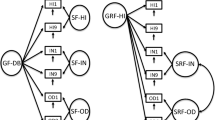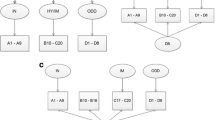Abstract
Questions persist about whether attention deficit hyperactivity disorder (ADHD), oppositional defiant disorder (ODD), and conduct disorder are in fact distinct from one another. When such questions arise, ODD is often suggested to be subsumed under one or the other condition. Modeling approaches that can evaluate whether specific subfactors can be distinguished from general psychopathology are of great interest, and the general bifactor model has been increasingly applied in studies evaluating the structure of psychopathology. However, evidence for bias in the model, the frequency of anomalous indicators, and theoretical concerns about the applicability of the general bifactor model to these questions raise doubts about whether it is reliable or appropriate to do so. Burns and colleagues propose the bifactor S-1 model as a psychometrically sounder alternative. Their systematic examination provides a compelling argument that it is psychometrically sounder, but it is not clear that it is a true alternative. It may not be answering the same questions, cannot test hypotheses regarding the same sets of specific subfactors, and relies on a priori decisions on the part of the researcher that may change the interpretation of the results. The bifactor S-1 model approach appears to be a valuable, psychometrically sound approach to test the structure of psychopathology, particularly in regard to ADHD and ODD.
Similar content being viewed by others
References
Angold, A., Costello, E. J., & Erkanli, A. (1999). Comorbidity. Journal of Child Psychology and Psychiatry, and Allied Disciplines, 40(1), 57–87.
Biederman, J., Petty, C. R., Clarke, A., Lomedico, A., & Faraone, S. V. (2011). Predictors of persistent ADHD: An 11-year follow-up study. Journal of Psychiatric Research, 45(2), 150–155.
Bonifay, W., Lane, S. P., & Reise, S. P. (2017). Three concerns with applying a bifactor model as a structure of psychopathology. Clinical Psychological Science, 5(1), 184–186.
Burke, J. D., Loeber, R., Lahey, B. B., & Rathouz, P. J. (2005). Developmental transitions among affective and behavioral disorders in adolescent boys. Journal of Child Psychology and Psychiatry, 46(11), 1200–1210. https://doi.org/10.1111/j.1469-7610.2005.00422.x.
Burke, J. D., Boylan, K., Rowe, R., Duku, E., Stepp, S. D., Hipwell, A. E., & Waldman, I. D. (2014). Identifying the irritability dimension of ODD: Application of a modified bifactor model across five large community samples of children. Journal of Abnormal Psychology, 123(4), 841–851.
Caspi, A., Houts, R. M., Belsky, D. W., Goldman-Mellor, S. J., Harrington, H., Israel, S., et al. (2014). The p factor: One general psychopathology factor in the structure of psychiatric disorders? Clinical Psychological Science, 2(2), 119–137.
Dick, D. M., Viken, R. J., Kaprio, J., Pulkkinen, L., & Rose, R. J. (2005). Understanding the covariation among childhood externalizing symptoms: Genetic and environmental influences on conduct disorder, attention deficit hyperactivity disorder, and oppositional defiant disorder symptoms. Journal of Abnormal Child Psychology, 33(2), 219–229.
Evans, S. C., Burke, J. D., Roberts, M. C., Fite, P. J., Lochman, J. E., Francisco, R., & Reed, G. M. (2017). Irritability in child and adolescent psychopathology: An integrative review for ICD-11. Clinical Psychology Review,
Faraone, S. V., Biederman, J., Spencer, T. J., & Aleardi, M. (2006). Comparing the efficacy of medications for ADHD using meta-analysis. Medscape General Medicine, 8(4), 4.
Frick, P. J., & Nigg, J. T. (2012). Current issues in the diagnosis of attention deficit hyperactivity disorder, oppositional defiant disorder, and conduct disorder. Annual Review of Clinical Psychology, 8, 77–107. https://doi.org/10.1146/annurev-clinpsy-032511-143150.
Greene, A. L., Eaton, N. R., Li, K., Forbes, M. K., Krueger, R. F., Markon, K. E., et al. (2019). Are fit indices used to test psychopathology structure biased? A simulation study. Journal of Abnormal Psychology, 128(7), 740–764.
Hambly, J. L., Khan, S., McDermott, B., Bor, W., & Haywood, A. (2016). Pharmacotherapy of conduct disorder: Challenges, options and future directions. Journal of Psychopharmacology, 30(10), 967–975.
Moffitt, T. E., Arseneault, L., Jaffee, S. R., Kim-Cohen, J., Koenen, K. C., Odgers, C. L., et al. (2008). Research review: DSM-V conduct disorder: Research needs for an evidence base. Journal of Child Psychology and Psychiatry, 49(1), 3–33. https://doi.org/10.1111/j.1469-7610.2007.01823.x.
Poulton, A. S. (2011). Time to redefine the diagnosis of oppositional defiant disorder. Journal of Paediatrics and Child Health, 47(6), 332–334.
Rey, J. M., Bashir, M. R., Schwarz, M., Richards, I. N., Plapp, J. M., & Stewart, G. W. (1988). Oppositional disorder - fact or fiction. Journal of the American Academy of Child and Adolescent Psychiatry, 27(2), 157-162. Doi. https://doi.org/10.1097/00004583-198803000-00004.
Roy, A., Hechtman, L., Arnold, L. E., Sibley, M. H., Molina, B. S., Swanson, J. M., et al. (2016). Childhood factors affecting persistence and desistence of attention-deficit/hyperactivity disorder symptoms in adulthood: Results from the MTA. Journal of the American Academy of Child & Adolescent Psychiatry, 55(11), 937–944.
Snyder, H. R., Young, J. F., & Hankin, B. L. (2017). Strong homotypic continuity in common psychopathology, internalizing, and externalizing-specific factors over time in adolescents. Clinical Psychological Science, 5(1), 98–110.
van Bork, R., Epskamp, S., Rhemtulla, M., Borsboom, D., & van der Maas, H. L. (2017). What is the p-factor of psychopathology? Some risks of general factor modeling. Theory & Psychology, 27(6), 759–773.
Vidal-Ribas, P., Brotman, M. A., Valdivieso, I., Leibenluft, E., & Stringaris, A. (2016). The status of irritability in psychiatry: A conceptual and quantitative review. Journal of the American Academy of Child & Adolescent Psychiatry.
Waldman, I. D., Rowe, R., Boylan, K., & Burke, J. D. (2018). External validation of a bifactor model of oppositional defiant disorder. Molecular Psychiatry, 1–12.
Author information
Authors and Affiliations
Corresponding author
Additional information
Publisher’s Note
Springer Nature remains neutral with regard to jurisdictional claims in published maps and institutional affiliations.
Rights and permissions
About this article
Cite this article
Burke, J.D., Johnston, O.G. The Bifactor S-1 Model: a Psychometrically Sounder Alternative to Test the Structure of ADHD and ODD?. J Abnorm Child Psychol 48, 911–915 (2020). https://doi.org/10.1007/s10802-020-00645-4
Published:
Issue Date:
DOI: https://doi.org/10.1007/s10802-020-00645-4




